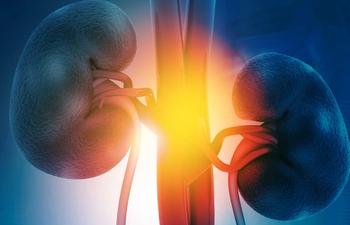
First-Line Atezolizumab/Bevacizumab Well-Tolerated in Metastatic RCC
Adding atezolizumab and bevacizumab to standard care was tolerable and slowed tumor growth in patients with previously untreated clear-cell or sarcomatoid-histology metastatic renal cell carcinoma when compared to sunitinib, according to findings from a phase III study.
Adding the immune checkpoint inhibitor atezolizumab and bevacizumab to standard care was tolerable and slowed tumor growth in patients with previously untreated clear-cell or sarcomatoid-histology metastatic renal cell carcinoma (RCC) when compared to sunitinib, according to findings from the phase III IMmotion 151 study. The data were presented (abstract 578) ahead of the 2018 Genitourinary Cancers Symposium, held February 8–10 in San Francisco.
The findings were stronger for patients with programmed death-ligand 1 (PD-L1)–positive tumors, reported lead study author Robert J. Motzer, MD, of the Memorial Sloan Kettering Cancer Center in New York.
Atezolizumab blocks PD-L1 and like sunitinib, bevacizumab is a vascular endothelial growth factor–targeted agent that inhibits tumors’ recruitment of new blood vessels.
The authors enrolled 915 treatment-naive patients of any prognostic risk category and randomly assigned them to receive atezolizumab (1,200 mg intravenously every 3 weeks) plus bevacizumab (15 mg mg/kg IV every 3 weeks) or sunitinib (50 mg orally daily for a cycle of 4 weeks on, 2 weeks off). Patients were stratified by PD-L1 status (< 1% or ≥ 1% PD-L1 expression on tumor-infiltrating immune cells).
At a median follow-up of 15 months, overall response rates (ORR) for the intent-to-treat population were 37% (5% complete response [CR]) for the atezolizumab plus bevacizumab group vs 33% (2% CR) in the sunitinib group. Among patients with PD-L1–positive disease, ORR was 43% (9% CR) for patients receiving atezolizumab plus bevacizumab and 35% (4% CR) for those in the sunitinib group.
It was too early for an analysis of survival outcomes, Dr. Motzer said.
Atezolizumab plus bevacizumab demonstrated better investigator-assessed progression-free survival than sunitinib among patients with PD-L1–positive kidney cancer (11.2 months vs 7.7 months; hazard ratio, 0.74; 95% CI, 0.57–0.96; P = .02). However, that association was not clearly supported using independent, blinded reviewer-assessed progression-free survival, Dr. Motzer cautioned.
Safety results were similar for all patients in the study, but grade 3/4 adverse events were more frequent among patients receiving sunitinib.
“The side effects of atezolizumab plus bevacizumab were decidedly less harsh than sunitinib,” Dr. Motzer said, noting fewer high-grade treatment-related adverse events and lower steroid use among patients in the atezolizumab plus bevacizumab study group, compared to patients receiving sunitinib. Sixteen percent of patients receiving atezolizumab plus bevacizumab required systemic corticosteroid use within 30 days of an adverse event.
The findings support consideration of atezolizumab plus bevacizumab as a first-line treatment option for patients with PD-L1–positive advanced RCC, Dr. Motzer concluded.
Newsletter
Stay up to date on recent advances in the multidisciplinary approach to cancer.


















































































